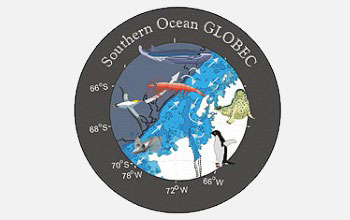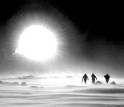|

Press Release 01-030
NSF Ships to Probe Biological Enigmas of the Frozen Southern Ocean

April 17, 2001
This material is available primarily for archival purposes. Telephone numbers or other contact information may be out of date; please see current contact information at media contacts.
See progress reports from the NSF research vessel Nathaniel B. Palmer, by Aparna Sreenivasan, a student in the science communication program at the University of California at Santa Cruz and a member of the NSF's SO GLOBEC research cruise to Antarctic Peninsula.
Trillions of small, shrimp-like animals called krill form the base of a food chain that supports untold numbers of penguins, seals and whales in the biologically productive waters off Antarctica. But how Antarctic krill survive the long, cold, pitch-dark austral winter and what role algae that thrive on ice play in their survival are among many mysteries of life in the Southern Ocean.
In late April, two icebreaking research ships operated by the National Science Foundation (NSF) will sail from Chile for the Antarctic Peninsula as part of precedent-setting international oceanographic survey to try to answer those and many other questions, including how larger predators like seals and whales survive the severe polar winter.
"What happens in the winter determines how productive the ecosystem is," said Eileen Hofmann of Old Dominion University in Norfolk, Va., one of several U.S. researchers who will take part in the international Southern Ocean Global Ecosystems Dynamics (SO GLOBEC) survey. "How well the krill do during the winter sets their spawning capacity for the summer."
The science teams will sail aboard the U.S. Antarctic Program vessels Laurence M. Gould and Nathaniel B. Palmer as part of a multinational effort that also will include research cruises by vessels from Germany, the United Kingdom, and Korea. SO GLOBEC is part of the wider U.S. GLOBEC program which studies how climate changes affect marine life.
Although conducting shipboard science in the austral winter is not unprecedented, the scale and technological sophistication of the SO GLOBEC cruise, as well as the cooperative aspects of the undertaking, make the venture unique, according to researchers. Hofmann noted, for example, that SO GLOBEC will for the first time include observers from the International Whaling Commission (IWC).
The Palmer and the Gould will work in company to obtain a depth and breadth of data that neither ship working singly could. The Palmer will carry out a geographically widespread survey of the western side of the Antarctic Peninsula centered on Marguerite Bay and thought to be one of the region's most important krill wintering sites. The Gould will simultaneously conduct detailed examinations of the water-column on the continental shelf and in the bay from a series of fixed locations.
"The Palmer will map the distribution of krill, phytoplankton, seabirds, mammals, whales and seals," explained Peter Wiebe, of the Woods Hole Oceanographic Institution in Woods Hole, Mass. "The Gould will investigate biological processes associated with these plants and animals." The ships are expected to return in June.
SO GLOBEC researchers have tagged penguins and seals so that they can be tracked by satellite, allowing scientist to refine their search areas.
The harsh conditions of the Southern Ocean at this time of year will test to the maximum the technological advantages the scientists enjoy, Wiebe noted. "Just the reality of learning how to carry out research aboard these vessels in ice-covered waters is going to be a tremendous challenge," he said.
Wiebe said that new technologies to be deployed on the cruise are expected to return a wealth of data previously unattainable. Although high-frequency acoustics is a standard tool to map the distribution of krill, no other existing system has the capability of the Bio-Optical Multi-frequency Acoustical and Physical Environmental Recorder (BIOMAPER-II), a device that the SO GLOBEC researchers will employ. The fiber-optic-based technology will allow the researchers to map the ocean to a depth of 500 meters (1642 feet). "We can actually see simultaneously up and down," Wiebe said. "This capability is going to give a far deeper reach into the water column. We going to be able see and actually quantitatively assess the abundance of krill at substantial depths."
See also: PR 02-36 -- "Ships Return to the Southern Ocean to Enhance Understanding of Food Chain" for information on the second SO GLOBEC research cruise.
-NSF-

Media Contacts
Peter West, NSF (703) 292-7761 pwest@nsf.gov

The National Science Foundation (NSF) is an independent federal agency that supports fundamental research and education across all fields of science and engineering. In fiscal year (FY) 2009, its budget is $9.5 billion, which includes $3.0 billion provided through the American Recovery and Reinvestment Act. NSF funds reach all 50 states through grants to over 1,900 universities and institutions. Each year, NSF receives about 44,400 competitive requests for funding, and makes over 11,500 new funding awards. NSF also awards over $400 million in professional and service contracts yearly.
 Get News Updates by Email Get News Updates by Email
Useful NSF Web Sites:
NSF Home Page: http://www.nsf.gov
NSF News: http://www.nsf.gov/news/
For the News Media: http://www.nsf.gov/news/newsroom.jsp
Science and Engineering Statistics: http://www.nsf.gov/statistics/
Awards Searches: http://www.nsf.gov/awardsearch/
| 




